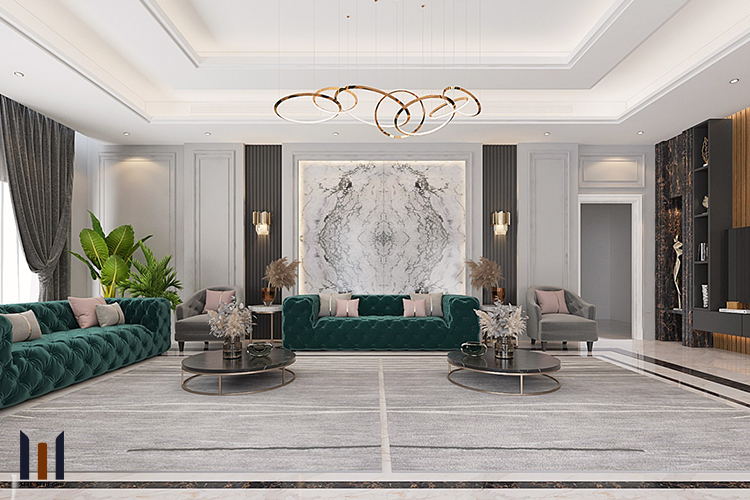salon designStep into the world of ancient Greece, and you’re stepping into a world of timeless beauty and elegance. From the grand temples dedicated to the gods to the humble homes of everyday people, ancient Greek architecture was a marvel of its time, and its influence still resonates today.
How did it start?

In ancient Greece, architecture was incredibly important and had a significant impact on society and human life. There were three main architectural styles: the Doric, Ionic, and Corinthian orders, all these styles emerged during the Archaic and Classical periods, from 800 to 323 BCE. They used these styles to build temples and sanctuaries for religious ceremonies. After that, the architectural styles became more refined during the Classical period. They focused on things like symmetry and harmony.
Architecture was not just practical, it was also about expressing beauty and ideas in greek. Philosophers like Plato and Aristotle talked about the importance of interior design and the relationship between architecture and human experience! They believed that beautiful buildings represented culture and moral goodness. So the design of buildings was carefully planned to create balance and harmony when you look.
The architectural styles from ancient Greece still inspire architects all around the world today!
The Principles of Greek Interior Design:
In ancient Greek interior design, the fundamental design principles included:
- Symmetry
- Proportion
- Harmony
These principles were applied to different spaces, like temples to private residences. To get the best ancient Greek architecture interior, you can check out Choosing the Best Interior Company
Symmetry:
It was highly valued, with spaces often designed to have a balanced arrangement of elements on both sides.
Proportion:
It played a key role, with careful consideration given to the size and scale of architectural features of the overall space.
Harmony:
It was achieved through the careful selection and integration of materials, colors, and decorative elements.
All These principles were applied to create aesthetically pleasing and balanced interiors that reflected the ideals and the beauty of greek interior design.
What is the Architectural Elements in Greek interior design?

In ancient Greek interiors, there are key architectural elements included:
Columns:
Columns, often in the Doric, Ionic, or Corinthian orders, provided structural support and added visual interest.
Pediments:
Pediments, triangular structures above entrances or porticos, were adorned with sculptures depicting myths or important events.
Friezes:
Friezes, decorative bands, adorned walls and showcased intricate relief carvings.
Frescoes:
- Frescoes, vibrant paintings on plaster, depicted scenes from mythology or everyday life.
- These elements were constructed using durable materials like marble and limestone. The decorative details were often crafted from clay or bronze.
- The use of these elements and materials not only served practical purposes but also held symbolic significance, representing the ideals of beauty in Greek interior design.
Ancient Greek interior spaces served various practical functions in religious rituals, social gatherings, and daily life. Temples and sanctuaries were dedicated to religious practices, serving as sites for rituals and ceremonies
The layout of the interior design of these spaces reflected the religious significance, with central halls and altar areas for worship. Greek society valued social interaction, and spaces like public squares and symposium rooms facilitated social gatherings, discussions, and entertainment. Private residences were designed to accommodate daily activities, with separate areas for dining, bathing, and sleeping. The functionality and purpose of these interior spaces reflected the values, and the importance of family and social connections in ancient Greek society. And if you want to make a mashup, you can watch Blending Tradition with Innovation to Create Modern Mix
How does Greek interior design inspire architects, designers, and artists today?
The impact of ancient Greek interior architecture is still felt today in modern design. Architects, designers, and artists draw inspiration from Greek principles like symmetry and harmony. You can see it in the columns they use, like the famous Doric and Ionic styles. These elements add a timeless elegance to buildings, whether they’re neoclassical or modern. Greek decorative motifs, like pediments and frescoes, also play a role in contemporary design, adding beauty and storytelling to spaces. Overall, the legacy of Greek interior architecture continues to shape and inspire the creative minds behind today’s designs.
Ancient Greek interior architecture has left an indelible mark on modern design, thanks to the Greek principles of symmetry, proportion, and harmony. Through the use of columns, pediments, friezes, and frescoes, ancient Greeks showcased their artistic prowess and talent for storytelling within their spaces. Today, these architectural elements continue to inspire everyone around the world and design styles, from neoclassical to modernist.
The Greek style emphasis on creating balanced and harmonious spaces, coupled with the incorporation of narrative and artistic elements, also brings depth and visual intrigue to contemporary interiors.
Today, these principles are cherished for their capacity to evoke a sense of beauty, order, and cultural heritage. The legacy of ancient Greek interior architecture remains deeply ingrained in the fabric of the design world, shaping our understanding and appreciation of architectural aesthetics in profound ways. At MatsMall we have very creative interior and exterior designers to help you to get the perfect design for your space, all you need just to fill the forum and we will contact you.


